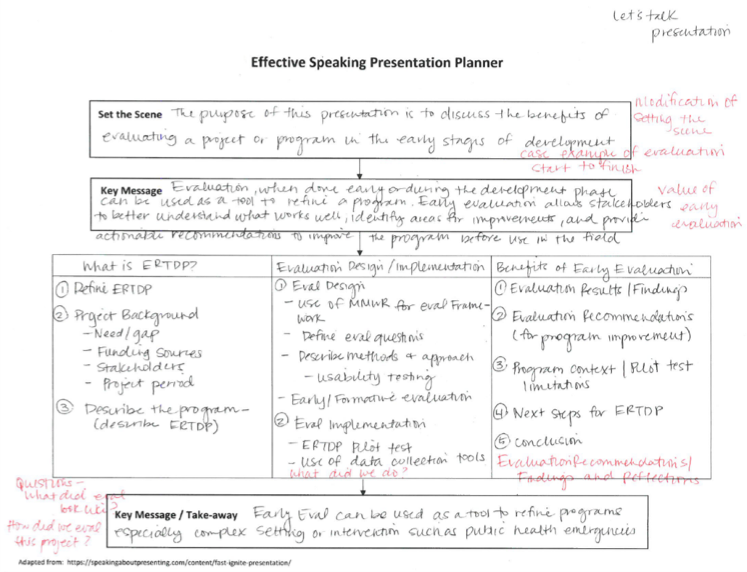Hi! I’m Brittnee Hawkins, an evaluator at Time Solutions, LLC. I currently work on evaluation projects in the Division of Laboratory Systems (DLS) at the Centers for Disease Control and Prevention (CDC) in Atlanta, GA.
I recently completed an evaluation of a training development process that could potentially be used during public health emergencies. I presented the findings to an internal audience at an informal, lunchtime speaker series where colleagues can share their work division-wide. The presentation provided an opportunity for colleagues to ask questions about the project and its evaluation, and share feedback on the findings before the evaluation report is complete. To develop the presentation in collaboration with DLS team members, and tailor the content to our audience, I searched for presentation planning tools and adapted them to meet our needs.
Rad Resources:
- I found Olivia Mitchell’s Effective Speaking Presentation Planner. Based in Wellington, New Zealand, she has a long history of providing training on presentation skills. Her open-access template helped me quickly outline the key points of my presentation in a format that made it much easier to get feedback from colleagues. The process of putting my ideas on a single page, and asking for feedback early, saved a lot of time when developing slides and talking points—everyone was on the same page, literally!
- I used the CDC Clear Writing Checklist to improve the quality of each sentence, eliminate jargon, and ensure that evaluators and non-evaluators could understand the information presented. While the checklist focuses on more traditional documents (i.e., not presentations), much of the content is applicable to any type of writing. The checklist provided important reminders regarding language and sentence structure that can be overlooked when working on a presentation.

Lessons Learned:
This was the first time I used a one-page template to lay out a presentation. In this case, a little planning went a very long way. Taking the time to outline the presentation forced me to distill the evaluation findings into meaningful, consumable bites of information. Discussion with colleagues to refine our one-page planning document contributed to decisions about when and how to use data visualizations graphics in the presentation. The process also gave my colleagues another opportunity to interact with the evaluation findings—we discovered the need for additional clarifications and contextual information to be presented with the data. Finally, our purposeful presentation sparked good discussion among those who attended and the feedback captured improved the evaluation report in meaningful ways.
You can explore additional resources on presentation skills via the AEA Potent Presentations Initiative (p2i).
The findings and conclusions in this report are those of the author(s) and do not necessarily represent the views of the Centers for Disease Control and Prevention.
Do you have questions, concerns, kudos, or content to extend this aea365 contribution? Please add them in the comments section for this post on the aea365 webpage so that we may enrich our community of practice. Would you like to submit an aea365 Tip? Please send a note of interest to aea365@eval.org. aea365 is sponsored by the American Evaluation Association and provides a Tip-a-Day by and for evaluators.
